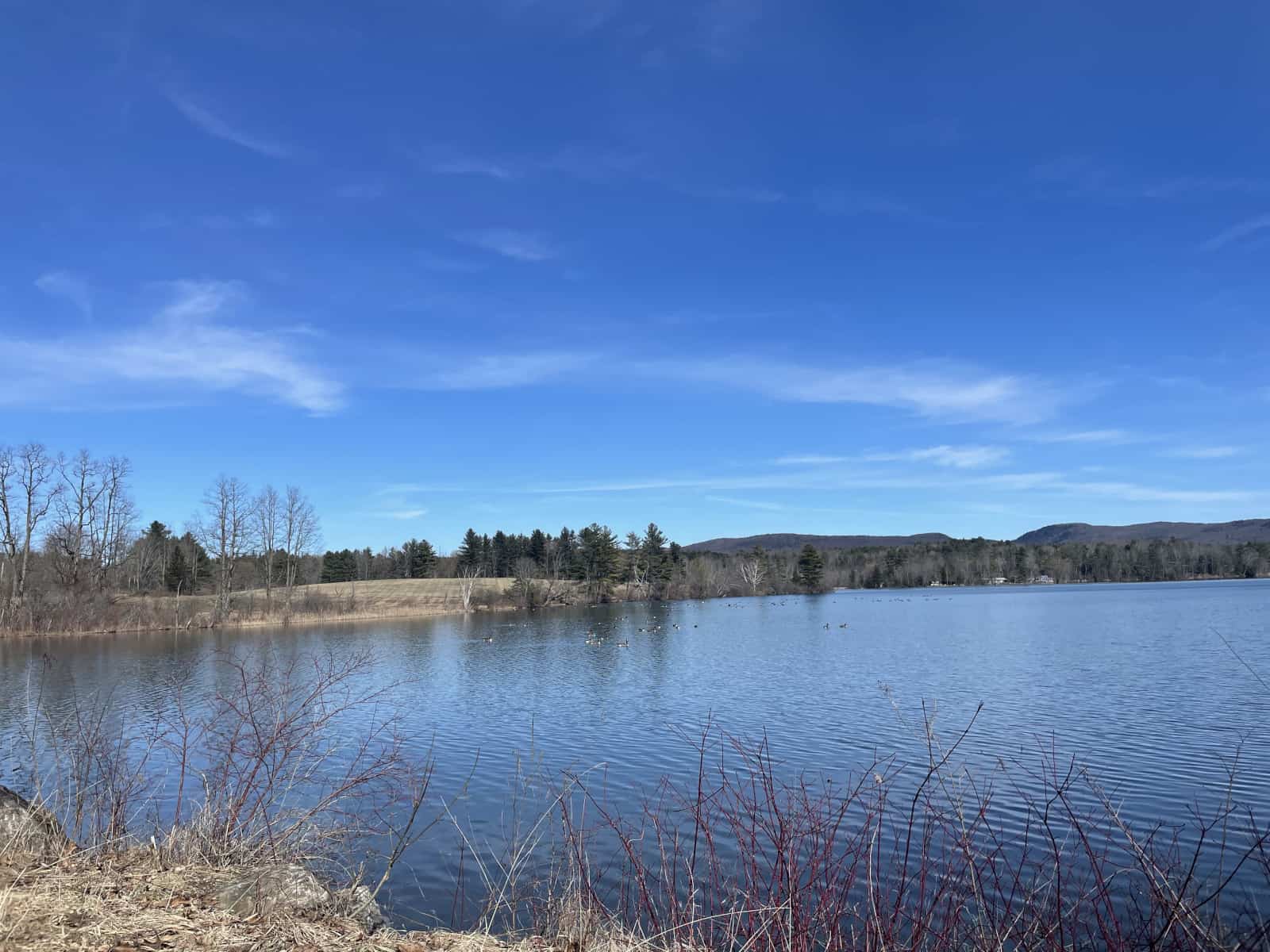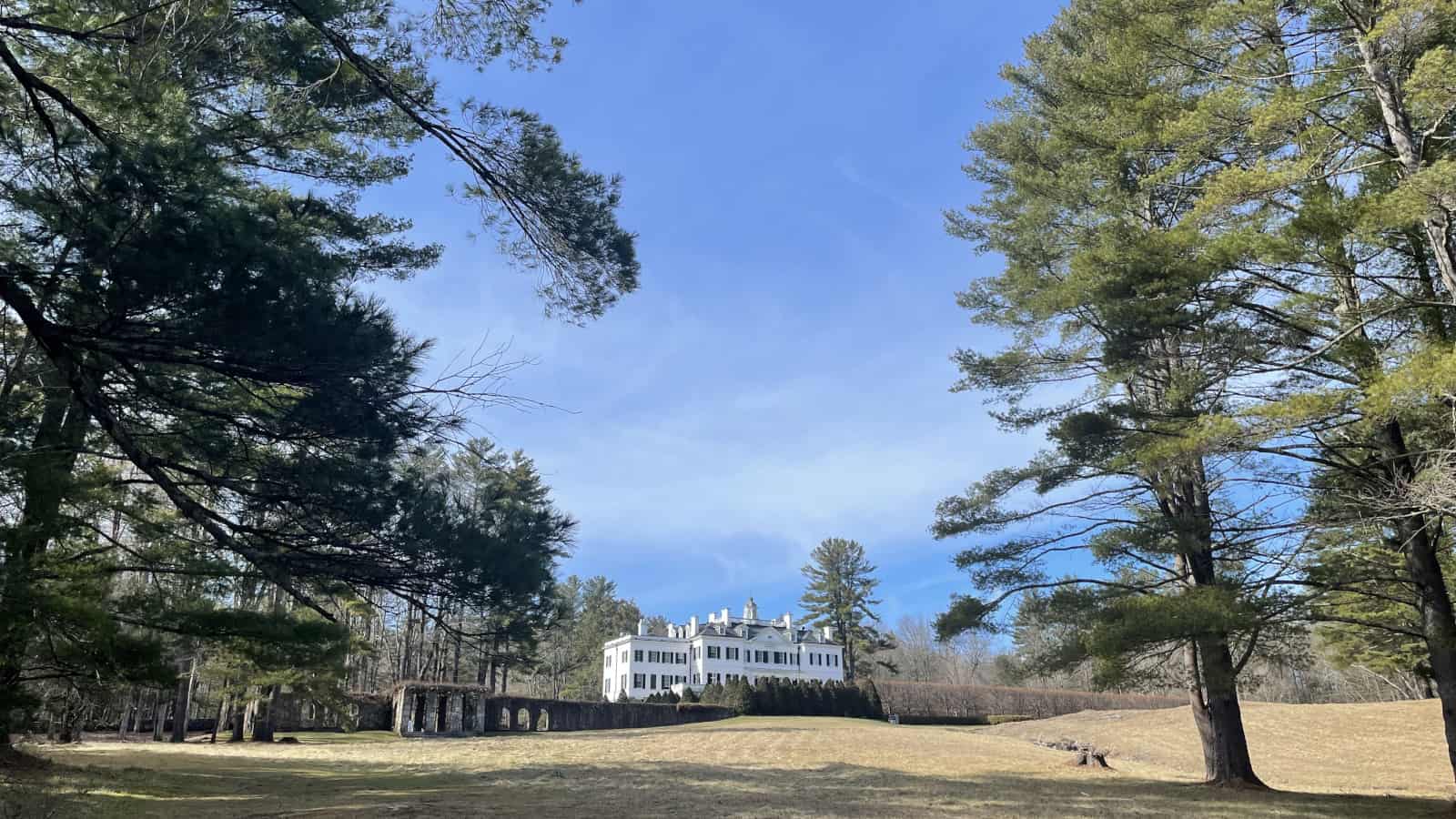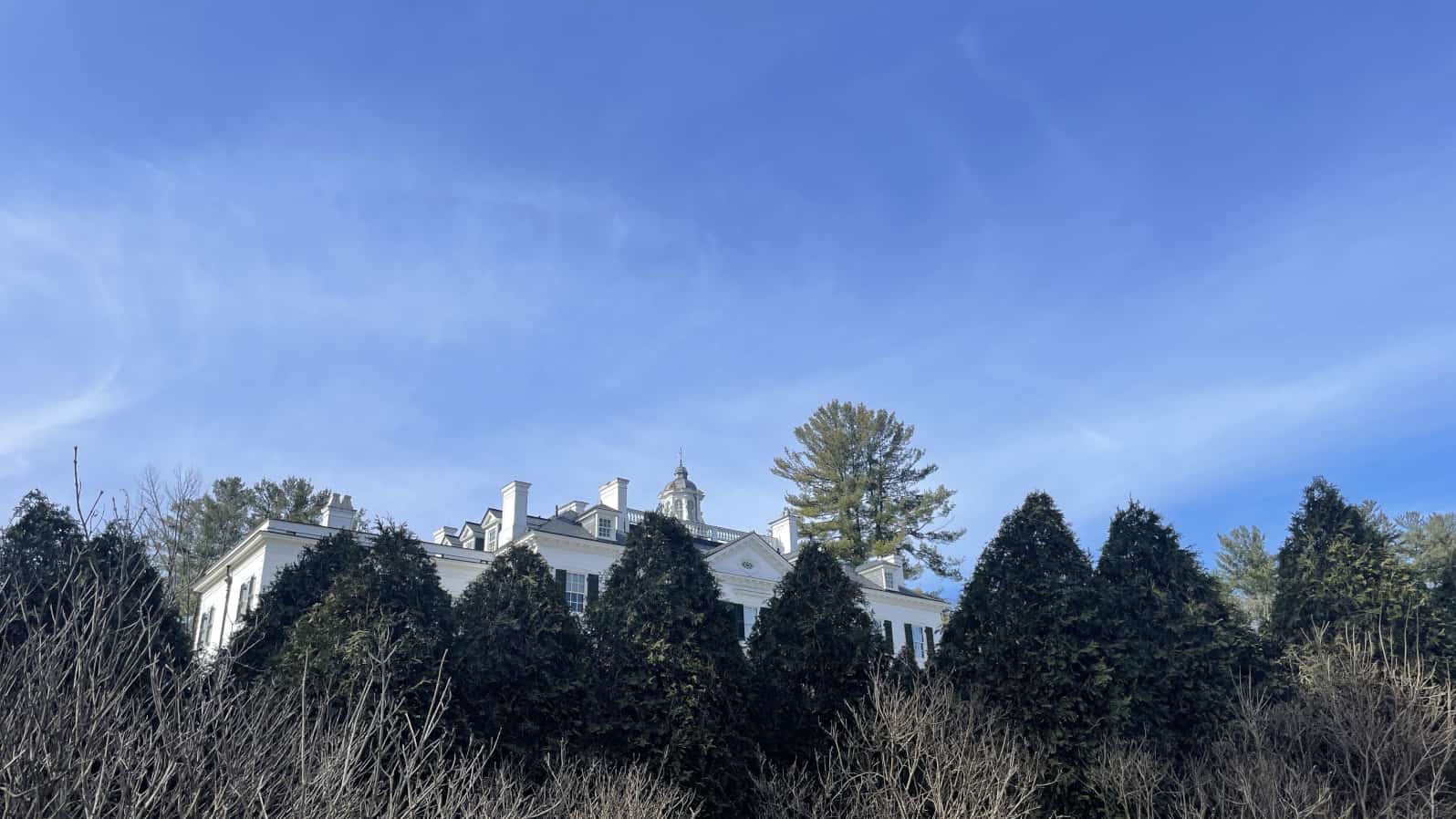Stevie Billow takes a break from an essay to watch the redwing blackbirds chase the fluff of cat tails in the marsh. Jenn Alandy Trahan is writing fiction in the room where Edith Wharton drafted stories in bed. And Camila Sanmiguel Anaya imagines lines of poems honoring the strength of her family in America and in Mexico.
At the beginning of spring, writers return to the Mount. Sitting in Wharton’s living room on a rare sunny afternoon, Billow, Trahan and Sanmiguel Anaya pause to reflect on their experiences in first week of the 10th annual residency for emerging writers, the Mount’s third year partnering with the Straw Dog Writers Guild in Northampton.
Sanmiguel Anaya has wanted and needed a sacred space for writing, she said. Billow has found a generous and rare sense of encouragement, and Trahan welcomes the time and permission to work on new stories tracing themes of identity, belonging and family.

Nationally acclaimed poet Camila Anaya Sanmiguel stands smiling by an open doorway. Press photo courtesy of the poet
“The experience has been magical,” she said. “This house represents history and literature in one space. … Something has crystalized for me since we toured Wharton’s library — there’s something about seeing the books she annotated and read.
“Seeing her copy of Jane Eyre, I remember reading it sophomore year in high school, and imagining that she loved and read this book … it connects people from different times, past and present.”
‘This residency has made me feel brave. It has given me a sense of affirmation and courage.’ — Camila Sanmiguel Anaya
As a Jones Lecturer at Stanford University and a former Wallace Stegeman Fellow, Trahan has come east from Palo Alto, Calif., where she and her spouse live with their daughter and two dogs.
She describes her time here as nurturing, dreaming. The first morning when she and Billow and Sanmiguel arrived, all the staff came to welcome them.
“Whenever I can feel a sense of family,” she said, “found family, chosen family, it means something to me.”
She has spent the week in Wharton’s inner chamber, exploring ideas she has touched on in earlier stories — like They Told Us Not to Say This in Harper’s — as a Filipina woman from Vallejo in the Bay Area finds a sense of courage and independence in her high school friends and team-mates.
‘The few white boys in our town could ball. Breakaway layups, nothing-but-the-bottom-of-the-net free throws, buzzer-beater fadeaways. They slept with basketballs in their beds and told us about their dreams. …’

Acclaimed fiction writer Jenn Alandy Trahan sits laughing in a wing chair. Press photo courtesy of the artist
In her own corner of the house, Sanmiguel Anaya has spent quiet days feeling her way into a work in progress, a collection of poems revolving around what one scholar calls the death world, she said. In Mexico, the political and social aftermath of the drug war have brought upheaval and violence. More than 100,000 people have been disappeared in the past 20 years.
‘Whenever I can feel a sense of family, found family, chosen family, it means something to me.’ — Jenn Alandy Trahan
In her poems, she is trying to find her way toward questions that are sometimes unanswerable, she said. She is probing her family’s own connection to disappearance and people lost. A poem for her can become a place of truth.
She has grown up near the border, she said, and as a National Student Poet of the Southwest, she has taught and given workshops and readings with families and children, advocates for immigrants and young refugees from 5 years old to 18. And she has listened to the stories they tell and the poems they write.
She has found in poetry a way to hold experiences that are almost too hard, too painful, too large to express, she said. And being here, in the restful quiet and companionship of this residency, has helped her to find words.
“I want to echo something Jenn said,” she said — “this residency has made me feel brave. It has given me a sense of affirmation and courage.
“This is a big topic to shoulder, and bear the emotional weight … of what happened to my cousin and my family, not knowing, as many families don’t know, where their body is, and having to reckon with these questions for the rest of your life, what happened to him, where is he now … I feel my poetry, what a poem has the power to do.”

Fiction and creative nonfiction writer, essayist, creator of community and teacher Stevie Billow holds a tulip, laughing, in a t-shirt and blazer. Press photo courtesy of the artist
Honesty and vulnerability are often hard to approach in writing, Billow agrees, and they value the sense of support they have found from everyone here, fellow writers and staff and all. They have in the past more often written fiction, vivid with natural metaphors, and in their time at the Mount they have been exploring creative nonfiction.
‘I have given myself permission to experience beauty and look around me in a way I haven’t felt in a long time.’ — Stevie Billow
“I’m working on an essay in a sense about trauma and transness,” they said, “as someone who grew up exposed to gendered and sexual violence. I struggle with representing myself and people like me.”
The Mount and Straw Dog’s responses give them affirmation.
“They want me to be here writing stories I thought no one would want to read,” Billow said, “because they’re difficult and messy.”
Many people have a misperception, they said, that transness is a reaction to trauma. Someone who has survived trauma will carry that experience, but for them living openly as a trans person is a source of joy, and very much separate from past experiences that have brought them pain.
They are naming a frustration with larger social forces that can constrain the ways trans folk have to tell their own stories.
“In order to access gender affirming healthcare,” they said. “Trans people have to misrepresent our own lived experiences to suit cisgender people’s narrative of a uniform trans experience. We are expected to hate our bodies, and gender affirming healthcare is only permissible when it is deemed a ‘life-saving’ alternative.
“The truth is, many trans people don’t hate their bodies or experience gender dysphoria as it is defined by cis society. And those trans people still pursue gender affirming healthcare and surgeries to improve their quality of life.”

The hills reflect in Laurel Lake on a still blue-sky early spring day.
Being here, they said, they have found space to enter into these challenging conversations. And they have found space to rest. They have given themselves permission to experience beauty and look around them in a way they have not felt in a long time.
Rest, all three writers agreed, is a powerful respite from the challenges in the world today. Looking around the carefully designed parlor, they saw reflections in the Gilded Age of tensions in the country today, and they valued writing like Wharton’s, with clear and honest insight.
In the house where she became a writer, they considered the contrasts of her independence, her wealth, her privilege, her insistent spirit. Sanmiguel Anaya remembered clearly one of Wharton’s books, Misrepresented Women, inscribed from a friend to “the most misrepresented woman.”

The Mount stands on the top of the rise, seen between the pine trees below Edith Wharton's gardens.
Thinking of Wharton’s struggle to re-invent herself, Sanmiguel Anaya compares her to the vivid, brilliant, challenging and ardent women in 19th-century French novels.
“They were complex women,” she said, “not perfect characters. They defied the social expectations and morality of the day — and I love thinking of myself and of Edith as complex women.”
Trahan warmly recalled their tour through Wharton’s library with the Mount’s librarian, Nynke Dorhout.
‘Now this space is so active in connecting with life — the grounds are open to the community, and people can come freely to walk in the gardens, and this residency is bringing us.’ — Stevie Billow
“She was real with us about Edith’s flaws,” Billow said, “which of course she had. Now this space is so active in connecting with life — the grounds are open to the community, and people can come freely to walk in the gardens, and this residency is bringing us, people who might not have access to this place while Wharton was here.”
The Mount has created for all three of them a sense of community, continuity and creativity — writers in the present, sitting with their notebooks and laptops, telling their own stories, and dreaming new futures.
“I was talking with a friend about what I’m doing here,” Sanmiguel Anaya said, “and he said it sounds as though the space is alive.”
This story first ran in the Berkshire Eagle inMarch 2024 — my thanks to features editor Jennifer Huberdeau.

